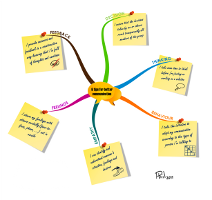 No doubts anymore for current or future users of iMindMap that a mind map software can cope with (wo)man’s creativity. Discover another nice looking mind map in the form of a tree created with iMindMap 5.
No doubts anymore for current or future users of iMindMap that a mind map software can cope with (wo)man’s creativity. Discover another nice looking mind map in the form of a tree created with iMindMap 5.
Cliquez ici pour voir la version française du billet
I’m happy to see how my last post about post-it in mind maps with iMindMap (beyond-limits-of-software) has been welcomed by the community. All of that is very new for me and this enthusiasm about my work can only boost me in doing more.
I’m happy to see how my last post about post-it in mind maps with iMindMap (beyond-limits-of-software) has been welcomed by the community. All of that is very new for me and this enthusiasm about my work can only boost me in doing more.
I was looking around on Biggerplate for nice mind maps. I mostly found a lot of great content about various subjects but presented with rather limited imagination. I have the impression (more than that, I’m a bit frightened) that computer based mindmapping is become so accessible and easy that mind map creators tend to forget the use of their right brain, one of the golden rules. We learned how important curves, images, dimensions, colors are essential in the creative thinking or memorisation process. If all the mind maps start to have the same 6 default colors, located at the same default position, displaying same kind of branches, using similar default central images or typical cliparts, we will quickly loose signs of imagination and creativity. The ultimate result is that more and more mind maps will appear approximately the same. This said, I don’t want to minimise the effort put into creating very interesting content in mind maps and having all of that accessible in a repository such as Biggerplate is wonderful. I’m just asking for more creativity and imagination when drawing them.
In order to remove some doubts current or future users of iMindMap might still have about the ability of the software to cope with (wo)man’s creativity, I’ve created another nice looking mind map in the form of a tree. You have already probably seen handmade mind maps with an old tree as a central image and wooden branches for developing the ideas. I just decided that it would be possible to create such a mind map with iMindMap 5. I’m proud of the the result that I’m posting here for you.
 |
| Causes and Effects of Deforestation or How to make a tree with iMindMap 5 |
Because I wanted to be complete in the approach, I selected a subject and quickly developed the ideas at first and second levels. It’s about the main causes and effects of deforestation. It’s just an example that illustrates the usage of the map. I invite you to take it as a template and adapt it for your own purpose. But maybe you don’t believe it’s a true iMindMap file so I also invite you to see the presentation mode in action.
I see several advantages with this kind of mind map:
- It has the look and feel of a drawing but it is a computer assisted mind map that you can adapt, edit and expand on the fly according to your need;
- It’s fresh, giving another dimension of something that could become at longer term boring, like most of freemind or mindmanager mind maps (again talking about the visual aspect, not the content);
- Because it’s quite different in the shaping, you might enjoy reading it more and need less effort to remember its content (or at least it will hit your mind more). If you look at it for a while and you close your eyes, you should be able to redraw it in your imagination and replace the content straight away;
- In the presentation mode, you will appreciate again the dynamic and originality of the flow, creating a “wow!” effect in the audience.
This kind of work is really inspiring me to go further in the domain. I have other ideas I will share with you very soon. In the meantime, if you have ideas about other out-of-the box mind maps I could try to draw, do not hesitate to post your suggestions. It will be a pleasure to sketch it.
For those who are interested by the iMindMap file, it is uploaded on the Biggerplate platform and accessible on http://www.biggerplate.com/mindmaps/rue92IJ8/philippe-packu-causes-and-effects-of-deforestation-or-how-to-to-make-a-tree-with-imindmap








